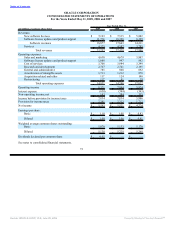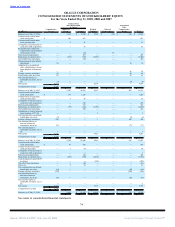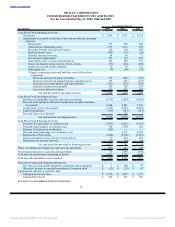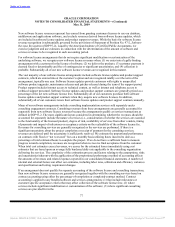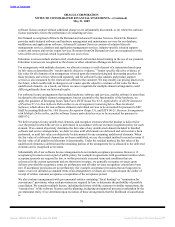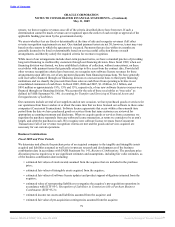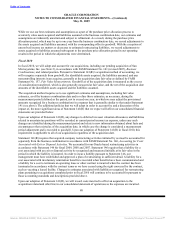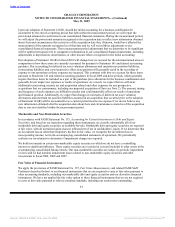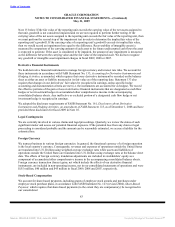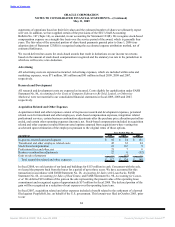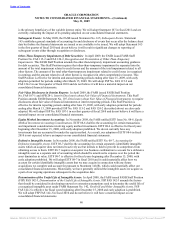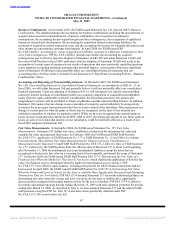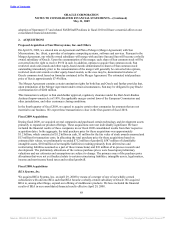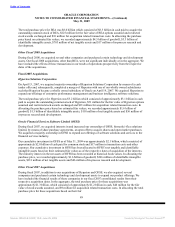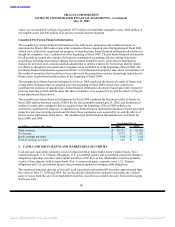Oracle 2008 Annual Report Download - page 90
Download and view the complete annual report
Please find page 90 of the 2008 Oracle annual report below. You can navigate through the pages in the report by either clicking on the pages listed below, or by using the keyword search tool below to find specific information within the annual report.
Table of Contents
ORACLE CORPORATION
NOTES TO CONSOLIDATED FINANCIAL STATEMENTS—(Continued)
May 31, 2009
Based on the trading prices of our $10.25 billion and $11.25 billion senior notes outstanding as of May 31,
2009 and 2008, respectively, and the interest rates we could obtain for other borrowings with similar terms at
those dates, the estimated fair value of our borrowings at May 31, 2009 and 2008 was $10.79 billion and
$11.26 billion, respectively.
The additional disclosures regarding our fair value measurements are included in Note 4.
Allowances for Doubtful Accounts
We record allowances for doubtful accounts based upon a specific review of all significant outstanding
invoices. For those invoices not specifically reviewed, provisions are provided at differing rates, based upon
the age of the receivable, the collection history associated with the geographic region that the receivable was
recorded in and current economic trends.
Concentrations of Credit Risk
Financial instruments that are potentially subject to concentrations of credit risk consist primarily of cash and
cash equivalents, marketable securities and trade receivables. Our cash and cash equivalents are generally
held with a number of large, diverse financial institutions worldwide to reduce the amount of exposure to any
single financial institution. Investment policies have been implemented that limit purchases of marketable
debt securities to investment grade securities. We do not require collateral to secure accounts receivable. The
risk with respect to trade receivables is mitigated by credit evaluations we perform on our customers, the short
duration of our payment terms for the significant majority of our customer contracts and by the diversification
of our customer base. No single customer accounted for 10% or more of our total revenues in fiscal 2009,
2008 or 2007.
Other Receivables
Other receivables represent value-added tax and sales tax receivables associated with the sale of software and
services to third parties. Other receivables are included in prepaid expenses and other current assets in our
consolidated balance sheets and totaled $555 million and $672 million at May 31, 2009 and 2008,
respectively.
Property
Property is stated at the lower of cost or realizable value, net of accumulated depreciation. Depreciation is
computed using the straight-line method based on estimated useful lives of the assets, which range from one
to fifty years. Leasehold improvements are amortized over the lesser of estimated useful lives or lease terms,
as appropriate. Property is periodically reviewed for impairment whenever events or changes in circumstances
indicate that the carrying amount of an asset may not be recoverable. We did not recognize any significant
property impairment charges in fiscal 2009, 2008 or 2007.
Goodwill, Intangible Assets and Impairment Assessments
Goodwill represents the excess of the purchase price in a business combination over the fair value of net
tangible and intangible assets acquired. Intangible assets that are not considered to have an indefinite useful
life are amortized over their useful lives, which range from one to ten years. Each period we evaluate the
estimated remaining useful life of purchased intangible assets and whether events or changes in circumstances
warrant a revision to the remaining period of amortization.
The carrying amounts of these assets are periodically reviewed for impairment (at least annually for goodwill)
and whenever events or changes in circumstances indicate that the carrying value of these assets may not be
recoverable. The goodwill impairment analysis is comprised of two steps. In the first step, we compare the
fair value of each reporting unit to its carrying value. Our reporting units are consistent with the reportable
segments identified in
82
Source: ORACLE CORP, 10-K, June 29, 2009 Powered by Morningstar® Document Research℠



